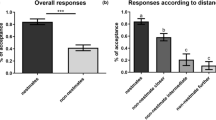Summary:
The oscillatory behavior of paper wasps, Polistes fuscatus, was examined in field observations (401.9 h) of 37 preworker (pre-emergence), multiple-foundress colonies. Additional field observations were conducted on 16 multiple-foundress colonies (96 h) both before and after worker emergence, and on 10 preworker colonies (40 h) before and after eggs had hatched into larvae. In addition, we observed 18 preworker, multiple-foundress colonies: six undisturbed controls (12 h), six larvae removed (12 h), and six larvae removed and replaced (12 h). Finally, we analysed video and audio sequences of oscillatory behaviors (lateral vibrations).¶ Higher ranked foundresses performed lateral vibrations (LVs) at a significantly greater rate than lower ranked foundresses. However, there was no significant association between rates of LVs and (1) aggression or (2) magnitude of differences in dominance indices among cofoundresses. There was also no significant temporal association between LVs and departures or returns. Lateral vibrations were commonly performed by foundresses that were alone on the nest. These results and others indicate that LVs do not function in adult-adult communication. ¶Lateral vibrations were significantly, temporally associated with high activity level, primarily cell inspection. Lateral vibrations were significantly, positively correlated with abdominal wagging and antennal drumming, both of which have been implicated in adult-larval communication. Foundresses of colonies containing eggs only (compared to colonies containing eggs and larvae) rarely displayed LVs. Removal of larvae significantly reduced the rates of LVs and the replacement of removed larvae caused a marked increase in the rates of LVs. Video analyses revealed that larvae retracted their head capsules in response to an LV. All of these data indicate that LVs involve adult-larval communication via substrate vibrations. Some indirect evidence suggests that LVs signal larvae to stop secreting saliva to adult wasps.
Similar content being viewed by others
Author information
Authors and Affiliations
Additional information
Received 7 July 1997; revised 8 January 1998; accepted 15 January 1998.
Rights and permissions
About this article
Cite this article
Savoyard, J., Gamboa, G., Cummings, D. et al. The communicative meaning of body oscillations in the social wasp, Polistes fuscatus (Hymenoptera, Vespidae). Insectes soc. 45, 215–230 (1998). https://doi.org/10.1007/s000400050082
Issue Date:
DOI: https://doi.org/10.1007/s000400050082




